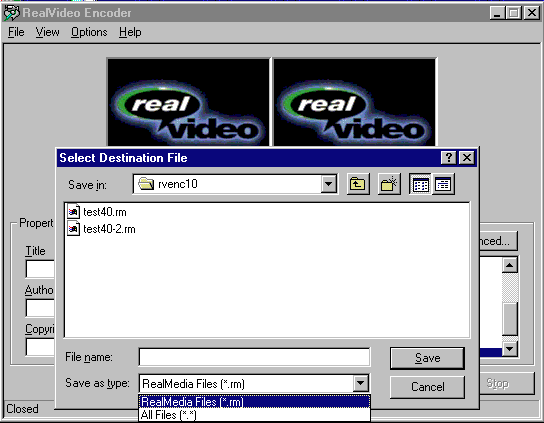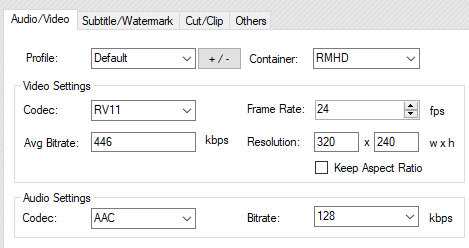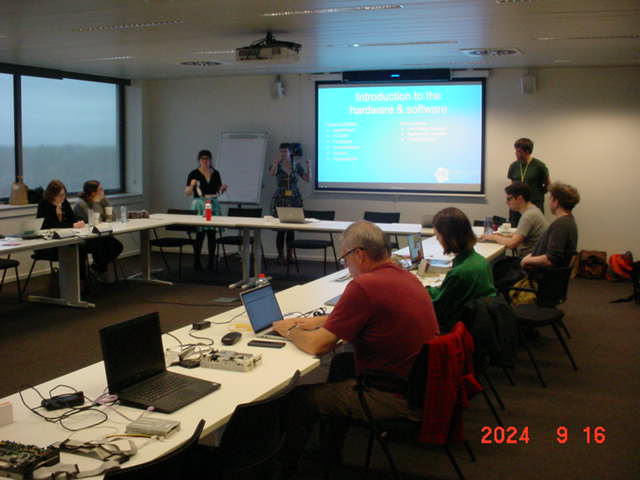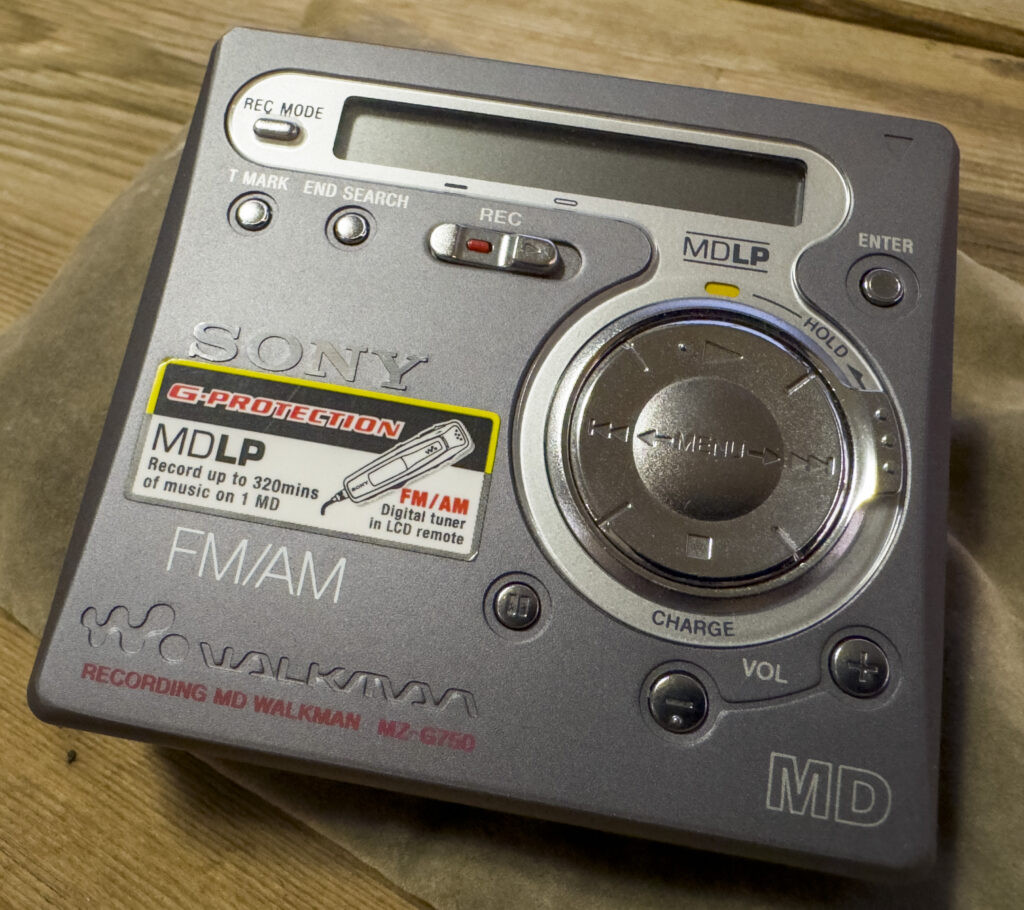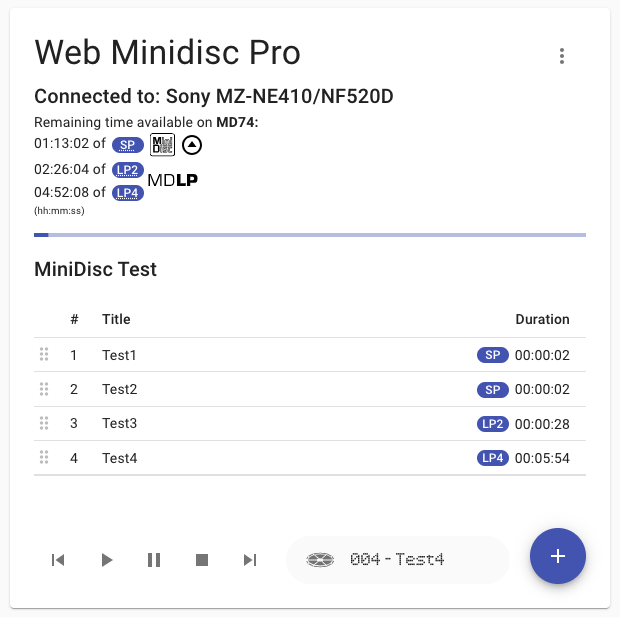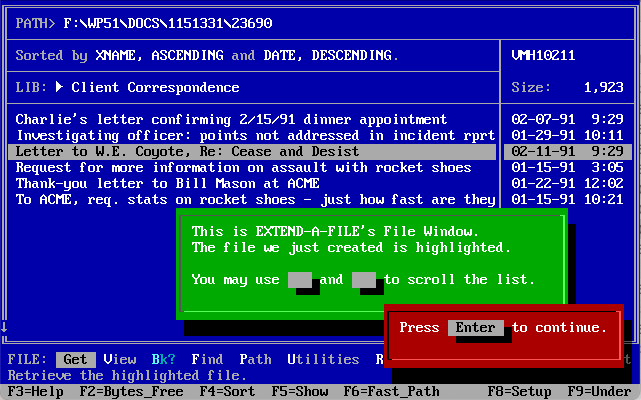A few of you may remember a couple years ago reading in a Vice article about Eric Roth and his use of an old DOS only software program for writing all his Hollywood scripts. The Vice article was based on some earlier reporting in 2014 about his writing process. You can watch the full interview of Eric Roth on YouTube.
I remember seeing a link to the Vice article a couple years ago and finding the screenwriters use of an old DOS program, Movie Master, funny and interesting. He says in his interview that out of half superstition and half fear of change he prefers to use this very old software to write his screenplays. It’s so old and obsolete, he can’t even email the files to Hollywood. He has to print them out and have the studio scan them into modern software for use. The interview shows the screen of his old Windows computer and you can see the software he is using.

Of course because I love researching obsolete software and formats so much, I wanted to know if the scripts generated by “Movie Master”, version 3.09, are in a format that needed to be documented. I was a little surprised that this version of Movie Master was no where to be found. It was on none of the old abandoned software sites. Not on Internet Archive, no where it seemed. I did find a later version of Movie Master, version 5, but found this software was not the same thing.
The original programmer of Movie Master was Adam Greissman, which you can clearly see in the screenshot above. The software was copyright Comprehensive Video Supply in the 1980’s, but the Movie Master version 5 was developed by Ballistic Software, Inc, which was also known as “Comprehensive Cinema Software” or “Hollywood Cinema Software” later in the 1990’s.
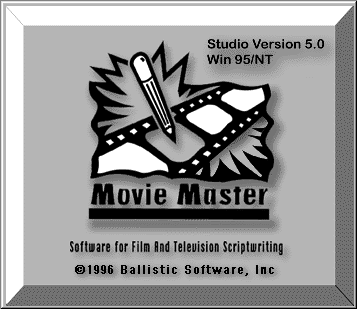
According to a very in depth article by Daniel Plagens, Reinventing the Typewriter, mentions Adam Greissman not wanting to move the software from DOS to Windows as he didn’t feel there was enough of a market at the time. As it turns out the founder of Comprehensive Video Supply, Jules Leni, got a lot of pressure from users of Movie Master after Greissman, who left the company in 1991, to develop a Windows and Macintosh version of the software. They released this new version in October of 1996.
Let’s take a look at a couple of example files from version 5.
hexdump -C Scene.scr | head
00000000 11 0d 0a 32 2e 20 20 20 20 15 0d 0a 15 0d 0a 15 |...2. .......|
00000010 0d 0a 15 0d 0a 11 0d 0a 10 0d 0a 15 0d 0a 15 0d |................|
00000020 0a 15 0d 0a 10 0d 0a 46 41 44 45 20 49 4e 3a 15 |.......FADE IN:.|
00000030 0d 0a 54 68 65 20 66 6f 6c 6c 6f 77 69 6e 67 20 |..The following |
00000040 22 73 63 72 69 70 74 6c 65 74 22 20 64 65 6d 6f |"scriptlet" demo|
00000050 6e 73 74 72 61 74 65 73 20 68 6f 77 20 4d 6f 76 |nstrates how Mov|
00000060 69 65 20 4d 61 73 74 65 72 20 0d 0a 63 61 6e 20 |ie Master ..can |
00000070 62 65 20 75 73 65 64 20 74 6f 20 6f 75 74 6c 69 |be used to outli|
00000080 6e 65 20 73 63 65 6e 65 73 2e 20 20 4f 6e 63 65 |ne scenes. Once|
00000090 20 79 6f 75 20 68 61 76 65 20 66 69 6e 69 73 68 | you have finish|
hexdump -C MM5-s01.scr | head
00000000 11 0d 0a 31 2e 20 20 20 20 15 0d 0a 15 0d 0a 15 |...1. .......|
00000010 0d 0a 15 0d 0a 11 0d 0a 10 0d 0a 15 0d 0a 15 0d |................|
00000020 0a 15 0d 0a 10 0d 0a 54 45 53 54 49 4e 47 15 0d |.......TESTING..|
00000030 0a 7e 60 21 40 23 24 25 5e 26 2a 28 29 2d 2b 7c |.~`!@#$%^&*()-+||
00000040 3d 2d 54 65 43 66 4d 74 0d 0a 01 00 00 07 00 02 |=-TeCfMt........|
00000050 00 00 00 00 00 00 01 00 00 01 00 00 01 00 00 01 |................|
00000060 00 00 01 00 00 01 00 00 01 00 00 01 00 00 01 00 |................|
00000070 00 01 00 00 bf 03 00 00 0c 00 43 6f 75 72 69 65 |..........Courie|
00000080 72 00 00 00 00 00 00 00 00 00 00 00 00 00 00 00 |r...............|
00000090 00 00 00 00 00 00 00 00 00 30 00 00 00 00 00 00 |.........0......|
Version 5 of Movie Master uses the extension SCR, which one could assume is short for “Script”. There does appear to be a header before any readable text starts, so that will be helpful in identification. Currently there is only one PUID, x-fmt/100, in PRONOM with the extension SCR, which happens to be for an AutoCAD script and has no signature, so anything you ask DROID or Siegfried to identify with the SCR extension will default to an AutoCAD script, which is frustrating. According to the File Format Wiki, there are quite a few formats with the SCR extension. More work to be done there for sure.
So I tried for a few weeks to find a copy of Movie Master version 3.09, I even put in a eBay favorite search for the name so it would alert me to a copy being sold, but no such luck. I gave up for awhile, then recently someone posted a link to a large collection of early warez. Warez is the name given to software that has been illegally copied. When I followed the link and searched though the vast amount of software titles, I got excited to see a couple matches to “Movie Master”. After a little wrangling of some downloads, I spun up a copy of DOSBox and low and behold, Movie Master 3.09!
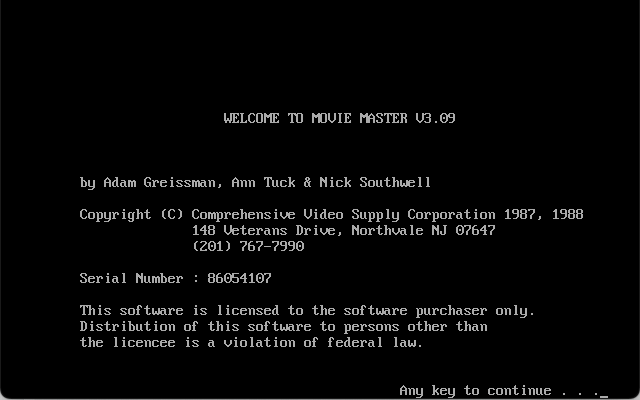
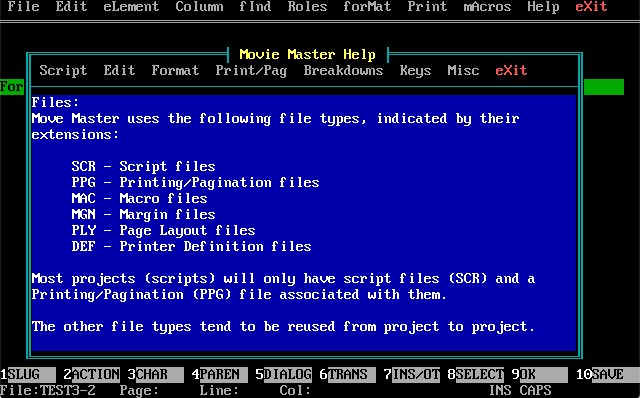
A lot of people have compared the old DOS scriptwriting tools to early word processors like Word, Perfect Writer, WordStar, etc. They did much of the same thing, but with special controls for helping with scenes, characters, indents, and everything writers needed to make some of the best Hollywood films out there. As Daniel Plagens noted:
The program proved popular for many years. Greissman estimates they sold over 10,000 units—“saturating the market,” as he put it—and recalls seeing help wanted ads in Hollywood Reporter and Variety where knowledge of Movie Master was a hiring requirement. He visited the sets of Days of Thunder and Hunt for Red October to help their writers and production teams acclimate to Movie Master.
Makes me wonder where all the old scripts from Hollywood movies are located in their electronic form? I am sure Eric Roth probably has quite the collection of different scripts he has written. I sure hope he backs them up and donates them to a library in the future.
Well, let’s take a look at a couple sample files from Movie Master version 3 and version 4. Version 4.04 was also in the collection uploaded to Internet Archive.
hexdump -C TEST3.SCR | head
00000000 33 2e 30 39 0a 00 00 00 00 31 00 00 00 00 00 00 |3.09.....1......|
00000010 31 00 00 00 00 00 00 0a 00 4e 41 4d 45 20 3f 0a |1........NAME ?.|
00000020 ff 53 43 52 45 45 4e 0a 2a 42 01 19 3c 01 1e 37 |.SCREEN.*B..<..7|
00000030 01 1c 2f 01 14 25 01 18 24 01 39 4c 01 31 42 01 |../..%..$.9L.1B.|
00000040 35 41 01 0a 46 01 0a 46 01 3d 4b 01 02 00 01 0a |5A..F..F.=K.....|
00000050 03 00 54 65 73 74 69 6e 67 20 4d 6f 76 69 65 20 |..Testing Movie |
00000060 4d 61 73 74 65 72 20 76 65 72 73 69 6f 6e 20 33 |Master version 3|
00000070 2e 30 39 11 11 31 11 31 0a |.09..1.1.|
hexdump -C TEST.SCR
00000000 34 2e 30 34 0a 00 00 00 00 31 00 00 00 00 00 00 |4.04.....1......|
00000010 31 00 00 00 00 00 00 00 00 00 00 00 00 00 00 0a |1...............|
00000020 ff 0a 2a 42 01 00 19 3c 01 00 1e 37 01 00 1c 2f |..*B...<...7.../|
00000030 01 00 14 25 01 00 18 24 01 00 39 4c 01 00 31 42 |...%...$..9L..1B|
00000040 01 00 35 41 01 00 0a 46 01 00 0a 46 01 00 3d 4b |..5A...F...F..=K|
00000050 01 00 0a 18 01 00 0a 46 01 00 02 00 00 54 68 69 |.......F.....Thi|
00000060 73 20 69 73 20 61 20 74 65 73 74 20 6f 66 20 4d |s is a test of M|
00000070 6f 76 69 65 20 4d 61 73 74 65 72 20 53 63 72 69 |ovie Master Scri|
00000080 70 74 20 77 72 69 74 69 6e 67 20 73 6f 66 74 77 |pt writing softw|
00000090 61 72 65 2e 0a 01 03 00 00 31 0a 01 00 00 00 00 |are......1......|
000000a0 0a 03 01 0a |....|
hexdump -C COVER.SCR | head
00000000 33 2e 30 35 0a 01 00 00 00 31 00 00 00 00 00 00 |3.05.....1......|
00000010 31 00 00 00 00 00 00 0a ff 43 4f 56 45 52 0a 2a |1........COVER.*|
00000020 42 01 19 3c 01 1e 37 01 1c 2f 01 14 25 01 18 24 |B..<..7../..%..$|
00000030 01 39 4c 01 31 42 01 35 41 01 0a 46 01 0a 46 01 |.9L.1B.5A..F..F.|
00000040 3d 4b 01 06 00 00 0a 03 01 31 0a 01 03 00 00 11 |=K.......1......|
00000050 11 11 11 11 11 11 11 11 11 11 11 11 11 11 11 11 |................|
00000060 11 11 11 11 11 11 11 11 20 20 20 20 20 20 20 20 |........ |
00000070 20 20 20 20 20 20 20 20 20 20 20 20 20 22 4d 65 | "Me|
00000080 65 74 20 74 68 65 20 44 72 61 63 75 6c 61 73 22 |et the Draculas"|
00000090 11 11 11 11 11 20 20 20 20 20 20 20 20 20 20 20 |.....
hexdump -C DRAC2.SCR | head
00000000 34 2e 30 30 0a 01 00 2b 00 36 00 00 00 00 00 00 |4.00...+.6......|
00000010 35 00 00 00 00 00 00 00 00 00 00 00 00 00 00 0a |5...............|
00000020 00 42 4f 42 0a 01 54 45 44 0a 02 43 41 52 4f 4c |.BOB..TED..CAROL|
00000030 0a 03 41 4c 49 43 45 0a 04 49 47 4f 52 0a 05 44 |..ALICE..IGOR..D|
00000040 45 4e 4e 49 53 0a 06 4d 55 46 46 49 4e 0a ff 53 |ENNIS..MUFFIN..S|
00000050 43 52 45 45 4e 0a 2a 42 01 00 19 3c 01 00 1e 37 |CREEN.*B...<...7|
00000060 01 00 1c 2f 01 00 14 25 01 00 18 24 01 00 39 4c |.../...%...$..9L|
00000070 01 00 31 42 01 00 35 41 01 00 0a 46 01 00 0a 46 |..1B..5A...F...F|
00000080 01 00 3d 4b 01 00 0a 18 01 00 0a 46 01 00 02 01 |..=K.......F....|
00000090 01 35 0a 03 00 45 58 54 20 54 45 44 20 44 52 41 |.5...EXT TED DRA|
The first thing to notice is they all start with the version number of the software which wrote the file. Really nice to have, but a terrible magic header. The files also all begin (after the version number) and end with the Hex value “0A”. Which happens to be a line feed control character. So super common, but could be helpful. Another pattern is that on the 9th byte it is “31” on most of the samples and “36” on one of them. “31” is the start of the ASCII number sequence, so could be the sequence number for the script as each SCR file could only store what was in memory.
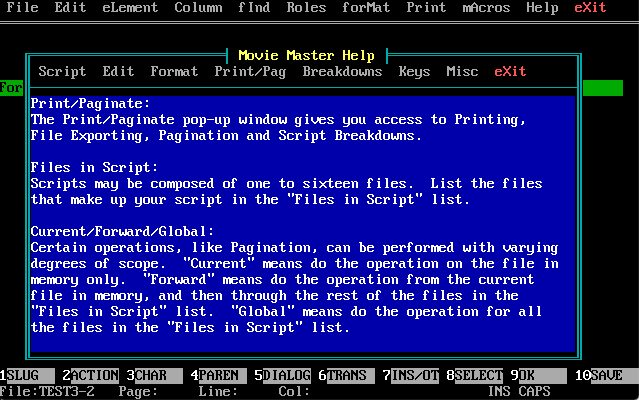
I fear the rest of the format will have the same issue most word processors had at the time which is not having a header, but lots of formatting codes which may or may not be in every file, making programatic identification difficult. Might take awhile to identify all the formatting codes, but could lead to better identification and possibly an import module for tools like LibeOffice or Final Draft.
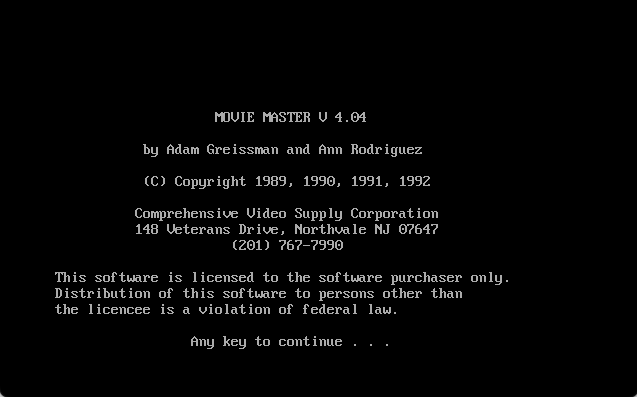
I didn’t find much different with Movie Master 4, seemed to have the same restrictions to 16 files in a script. The files from version 4 also seem to follow the same patterns from version 3. But both versions are different from the the Windows version of Movie Master, version 5. Click here for Movie Master 5 help menu on “Introduction for Movie Master DOS Users“.
There was another elusive script writing software title which adds to the confusion. Scriptware was another screenwriting software tool which seems to have had a large following. They produced a Windows and Macintosh version. It also started out for DOS and also used the SCR extension. The website is still active for the software, but hasn’t updated in 24 years. I wrote a little about in my post on PROmotion. All the demo versions out there are not useable demos, but animation demos. In this nice batch of old software on the Internet Archive I was able to find an early copy. Wasn’t able to get it to run, but the folder did have some samples.
hexdump -C SAMPLE1.SCR | head
00000000 32 5f 01 00 00 00 00 00 00 00 00 39 01 4a 5f 00 |2_.........9.J_.|
00000010 ff ff 2c 01 00 00 00 00 00 00 95 80 01 00 11 53 |..,............S|
00000020 63 72 69 70 74 77 61 72 65 20 53 63 72 69 70 74 |criptware Script|
00000030 00 00 00 00 00 00 00 00 00 00 00 00 00 00 00 00 |................|
*
000000b0 00 00 00 00 00 00 00 00 11 00 02 00 02 00 14 00 |................|
000000c0 12 00 6f 02 f9 04 0b 00 7b 04 01 00 05 00 00 02 |..o.....{.......|
000000d0 00 11 00 00 00 0c 00 00 00 06 00 ed 01 05 06 00 |................|
000000e0 00 00 00 00 08 00 0b 00 00 00 04 00 00 00 04 00 |................|
000000f0 82 00 01 01 00 00 00 00 00 00 00 00 00 00 00 00 |................|
hexdump -C SAMPLE2.SCR | head
00000000 0b 53 63 72 69 70 74 77 61 72 65 1a 95 80 04 80 |.Scriptware.....|
00000010 1e 53 63 72 69 70 74 77 61 72 65 20 53 63 72 69 |.Scriptware Scri|
00000020 70 74 20 32 2e 32 33 3a 34 3b 37 30 32 32 31 00 |pt 2.23:4;70221.|
00000030 00 00 00 00 00 00 00 00 00 00 00 00 00 00 00 00 |................|
*
000000a0 00 00 00 00 00 00 00 00 00 00 11 00 02 00 02 00 |................|
000000b0 11 00 00 00 34 02 01 05 0b 00 89 04 01 00 05 00 |....4...........|
000000c0 00 02 00 11 00 00 00 0b 00 00 00 06 00 aa 01 05 |................|
000000d0 06 00 00 00 00 00 08 00 0c 00 00 00 05 00 00 00 |................|
000000e0 05 00 8a 00 01 01 00 00 00 00 00 00 00 00 00 00 |................|
Luckily, they make it quite easy to identify these SCR files. ScriptWare was very popular and continued on with Windows and Macintosh versions. Later on, the format was changed along with the extension, which changed to SW3.
The SCR extension has been used often. On my desktop they default as a Paintbrush document. Apparently SCR is sometimes used as an extension for the ZSoft Paintbrush (PCX) format. It is also used on older postscript fonts on the Macintosh as a Type 1 screen font. Can also be a screensaver on Windows, but watch out, they can hide malicious code. You get the idea, SCR is a very common extension, identifying it up front can help avoid problems later!
Moral of the story is to never give up searching for old software and even though illegal copying of software should be avoided, I am grateful to those who help save abandoned software. Without them many titles would be lost.
I don’t have a good signature for these formats yet, but you can find a few samples on my GitHub page.










